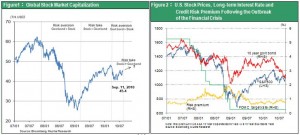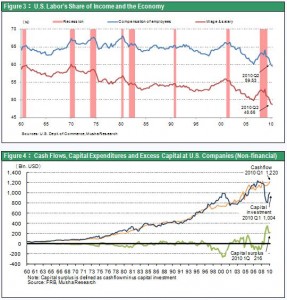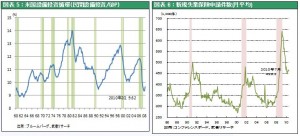Plunging asset prices = Recovery scenario = Deflation scenario = Next is the scenario for another recovery!?
Economies and stock prices worldwide have staged a V-shaped recovery during the 13-month period following the financial crisis that hit bottom in March 2009. But the scenario for a steady recovery has been put on hold since the Greek financial crisis in May. As a result, factoring in the global deflation scenario has been the central theme of financial markets. Some investors viewed a number of factors as reasons to expect another financial crisis and global deflation. These factors include (1) the Greek and euro crisis (often called the sovereign debt crisis, but the actual nature of the crisis is different); (2) fears of another U.S. economic downturn; (3) concerns about the bursting of China’s real estate bubble and resulting economic slowdown; and (4) the effects of tighter regulations on the financial sector. As stock prices fell, investors bought the government bonds of major countries like the U.S., Japan, U.K. and Germany and long-term interest rates dropped quickly as a result. The yen strengthened as a conditioned response to these events. Consequently, in international financial markets dominated by the global deflation scenario, investors clung to the belief that the “yen is king” rather than simply “cash is king.”
Excessive risk aversion is becoming dangerous
But enough is enough. Too much risk avoidance has become a risk itself. The preferences of investors are currently shifting. (1) Long-term interest rates have started to increase rapidly as investors began to reduce overbought positions in bonds in August. (2) Stock prices in the US and Europe are rebounding after the latest downturn ended in early July. European stock indices are now at the highest point in four months. (3) The risk premium on U.S. corporate bonds has been declining since July. (4) The yield on Japanese government bonds has increased from 0.9% to 1.2%. All these changes make it increasingly likely that the theme of financial markets will shift to factoring in the scenario of another global economic recovery. In addition, we may see a shift in the direction of Japanese stocks and the yen, too.
Weakening belief in the global deflation scenario
Pessimists who insist that the subprime loan crisis is not over probably did not expect these changes to occur. Falling long-term interest rates between 2007, when the subprime loan crisis started, until the middle of 2008 were a precursor of even more problems. The credit risk premium increased as long-term interest rates declined. These events eventually triggered a plunge in stock prices and a further economic downturn. This time as well, there is a persistent decline in long-term interest rates just as in 2007. But as Figure 2 shows, unlike in 2007, there is absolutely no negative reaction in credit markets. In fact, the credit risk premium has been decreasing slowly since July. Stock prices are climbing and long-term interest rates are rebounding instead of falling. These changes show that investors have become more willing to take on risk in international financial markets since August.

For pessimists, the analysis clock has stopped
The belief that pessimists always resurrect is nothing more than the fatalistic view that “the outlook for the future is bleak due to the bursting of the bubble created by the accumulation of debt.” For example, The Financial Times published a column on August 31 by the well-known economists Vincent and Carmen Reinhart with a shocking warning to optimists who think the worst is over. They analyzed 15 economic crises that occurred over the past 75 years. For financial crises caused by the accumulation of too much debt, they concluded that a significant decline in economic growth, higher unemployment and sluggish asset prices are all unavoidable. The Reinharts also believe that emergency countermeasures make the situation even worse. Besides, almost all pessimists share the same shortcoming: the lack of thorough analysis of this crisis and of any rigorous monitoring of subsequent economic and market trends. Pessimists are using clocks that stopped early in 2008 when there was too much debt and the bubble burst. As a result, the attitude of pessimists cannot be called fair. This downturn is similar to past recessions because too much debt led to the end of a bubble and a subsequent severe recession. But this similarity is no reason to assume that this financial crisis will inevitably end in the same way as tragic crises in the past. The current recession also has extremely positive characteristics that did not exist during previous downturns.
The characteristics of this recovery that pessimists are ignoring
Examples include:
(1) There has been a sharp rebound in prices of assets, and especially credit assets, after these prices plummeted. Balance sheets of financial institutions recovered quickly as a result. This never happened after a financial crisis in the past. I think this quick recovery demonstrates that this downturn was made even worse by the emergence of a negative bubble. What do pessimists think of this?
(2) Productivity of workers at U.S. companies improved significantly during the recession, causing labor’s share of income to fall to an all-time low. In other words, the big increase in the unemployment rate was not caused solely by the financial crisis. There is no doubt that the revolution in corporate business models (business models that take advantage of the Internet revolution and economic globalization) was another factor. What do pessimists think of this?
(3) The volume of excess capital (due to strong cash flows and a steep decline in capital expenditures) at U.S. companies is unprecedented. Companies have no need to deleverage balance sheets (by repaying debt). What do pessimists think of this unusual financial strength even during a recession?
I don’t think there are any pessimists who can come up with a persuasive explanation of these facts. We believe that it is dangerous to declare that this crisis is similar to those in the past based simply on the patterns of past crises. One reason for this belief is that the subprime loan crisis and financial crisis were an entirely new type of crisis that caused international securities markets to collapse and then come back to life. Another reason is that the productivity revolution sparked by globalization and the Internet was one cause of the crisis.
Worsening sentiment is the only source of concern
As I have reported in the past, there are few reasons for any significant concerns about the U.S. economy in terms of fundamentals. Corrections have almost ended at companies, households and the housing sector. Almost all excesses have been eliminated by this process. In addition, there has been a powerful rebound in corporate earnings, which is a key engine for economic growth. Currently, U.S. companies have an unprecedented volume of capital (Figures 3, 4 and 5). However, the recovery in jobs is still weak. High unemployment is holding down the recovery in consumer spending and temporarily slowing economic growth following the completion of investments to restore inventories. Furthermore, the drop in housing demand following the end of a housing tax credit is creating growing fears of an end to U.S. economic growth once stimulus measures wind down. But it is not unusual at all for an upturn in employment to stop briefly in the early stage of an economic recovery. For economic recoveries in the past, the number of jobs started to increase an average of nine months after the recovery started. In particular, this recovery is characterized by a big improvement in labor productivity because of (1) globalization and (2) the Internet revolution. As a result, this jobless recovery is actually a productivity recovery. Currently, we are seeing signs that falling stock prices are eroding investor sentiment, which is causing the savings rate to climb and consumption to weaken. But I think there is absolutely no need to worry about this as long as the downturn in stock prices can be stopped (Figures 6 and 7).
The U.S. government is prepared to take immediate action if the economy weakens again
The U.S. government has assembled a complete menu of initiatives in order to prevent any deterioration in investor sentiment. Fed chairman Ben Bernanke has stated that he will take additional actions if necessary. Examples include an interest rate reduction on excess deposits at the Fed, a resumption of asset purchases and a pledge to keep interest rates low. Chairman Bernanke has spent much time studying the Great Depression. With this knowledge, he is thought to be almost certainly indirectly keeping in mind the importance of asset prices (especially stock prices). Pessimists are always worried that the Fed will be unable to take additional actions if there is market turmoil caused by a weakening dollar, rising interest rates or other events. But this is not a problem at all. In fact, the dollar’s strength and falling interest rates can be interpreted as a sign that financial markets are asking for more risk-taking and government initiatives.
Moreover, the Obama administration has announced a number of economic stimulus programs. Examples include (1) a plan for infrastructure investments, (2) a tax reduction for corporate investments and R&D expenditures and (3) a proposal to make the Bush tax reductions permanent (for households with an annual income of below $250,000).
I believe that we can conclude that there is now very little chance of the U.S. economy staging a second downturn or of the U.S. becoming mired in Japanese-style long-term deflation. If this is true, investors should refuse to adopt the stance of avoiding excessive risk.






